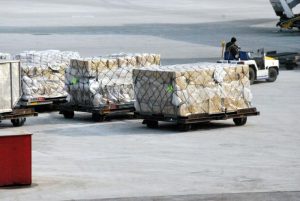One of the most complicated and expensive parts of running a business is getting your items from your warehouses to your customers. If you want to save money when shipping items for your business, you should consider palletized freight.
To find the right shipping solutions for your business, you’ll have to consider several different factors including the size and shape of your products or materials, the value of the products, and the means of transportation Choosing a suboptimal shipping option for your shipment will lead to unnecessary costs and frustration.
Let’s explore the details of what exactly palletized freight is and how it can help your business improve logistically.
What is Pallet Shipping?
Pallet shipping, also known as palletized freight, is a form of freight shipping. In this type of shipping, the shippers package the goods being transported on wood structures called pallets. The pallets help to stabilize and support the transported goods while they’re in transit. This can be done through road, maritime, rail and air shipments


Pallet shipping is distinct from standard shipping which uses packages. In standard shipping, the shipper places each item to be shipped in a package, typically a cardboard box. That package is also known as a parcel.
In general, standard shipping is a good option for shipments that include only one or two relatively light packages going to the same location. If you’re shipping many more packages all to the same place or shipping heavier items, palletized freight may be the better option.
How many Pallets Fit in a Shipping Container?
The number of pallets that will fit in a given shipping container depends on the size of the pallets and the size of the shipping container.
A 20-foot shipping container has internal dimensions of 19’ 4” long x 7’ 9” wide x 7’ 10” tall while the internal dimensions of a 40-foot container are 39’ 6” long x 7’ 9” wide x 7’ 10” tall.
Up to 20 North American standard pallets will fit in a standard 40-foot shipping container. In a 20-foot container, you can fit as many as 10 North American standard pallets.
It’s worth noting that there are two other common pallet types: EU pallets, EUR and standard pallet EUR2. The EU pallet measures 800 by 1200 mm (31.5 inches by 47 inches) and the standard pallet EU2 measures 1200 by 1000 mm (47 by 39 inches). That means that you can fit one or two extra pallets in a shipping container if you’re using one of these types of pallets instead of the North American standard pallets.
How to Pack Your Pallets for Optimal Pallet Freight
If you decide to move forward with a pallet freight solution, you’ll need to start putting your items on pallets when they’re ready to ship.
Choose the Right Pallet Size
The first step is to choose the right pallet size. You should choose a pallet that is big enough that everything you want to put on it will fit without hanging over the edge of the pallet. Before putting anything on the pallets, make sure that they’re sturdy enough to withstand the weight and volume of the items you intend to ship on them. A standard North American pallet can hold up to 4,600 pounds and must weigh at least 1,000 pounds. Check for protruding nails that can damage your items, too.
Strategically Arrange the Boxes
The next step in pallet freight is strategically arranging boxes on the pallet. Always put the heavier boxes on the bottom of the pallet, distributing the weight of the packages as evenly as possible. Continue adding progressively lighter packages to the load. All of the packages should be completed closed and secured with packing tape.
Try not to leave any extra space between boxes as you’re packing. They should be packed tightly together. You should also ensure the top layer of the boxes on the pallet is as flat as possible. In some cases, pallets get stacked on top of each other and a dome or pyramid-shaped load can lead to crushing and damage when stacked.
Secure the Load
After placing all the items you want to ship on the pallet, the next step is to secure the load by strapping everything together. This will prevent the packages from moving while they’re being shipped. It’s a good idea to wrap the shipment with stretch wrap at least five times to protect it from liquid and dust.
Label your Shipment
Finally, all you need to do is label your shipment and include all the documentation so it’s ready to go. Working through this palletizing system will be easier over time as you learn the easiest, safest methods for doing so. Once you (or your packing team) have it down, you can save significantly on shipping costs.
Some pallet freight shipping services will even do the packing for you so you can save even more time.
Why Choose Palletized Freight?
The benefit of choosing pallet freight shipping over other shipping options is that it allows you to save money and time when shipping large shipments to the same location. Palletized freight makes it easy to load, secure, and unload shipments.
Simply put, a palletized shipment is a streamlined transportation option that makes shipping more efficient and cost-effective.
Find a Shipping Solution for Your Business
If you need a logistics partner to help handle shipping and take your business to the next level, look no further than Boa Logistics.
Contact us to find opportunities to streamline your logistics and add value to your supply chain operations!
